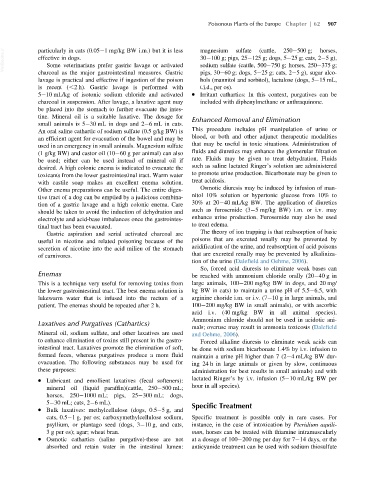Page 955 - Veterinary Toxicology, Basic and Clinical Principles, 3rd Edition
P. 955
Poisonous Plants of the Europe Chapter | 62 907
VetBooks.ir particularly in cats (0.05 1 mg/kg BW i.m.) but it is less magnesium sulfate (cattle, 250 500 g; horses,
30 100 g; pigs, 25 125 g; dogs, 5 25 g; cats, 2 5g),
effective in dogs.
sodium sulfate (cattle, 500 750 g; horses, 250 375 g;
Some veterinarians prefer gastric lavage or activated
charcoal as the major gastrointestinal measures. Gastric pigs, 30 60 g; dogs, 5 25 g; cats, 2 5 g), sugar alco-
lavage is practical and effective if ingestion of the poison hols (mannitol and sorbitol), lactulose (dogs, 5 15 mL,
is recent (,2 h). Gastric lavage is performed with t.i.d., per os).
5 10 mL/kg of isotonic sodium chloride and activated Irritant cathartics: In this context, purgatives can be
charcoal in suspension. After lavage, a laxative agent may included with diphenylmethane or anthraquinone.
be placed into the stomach to further evacuate the intes-
tine. Mineral oil is a suitable laxative. The dosage for Enhanced Removal and Elimination
small animals is 5 30 mL in dogs and 2 6 mL in cats.
An oral saline cathartic of sodium sulfate (0.5 g/kg BW) is This procedure includes pH manipulation of urine or
an efficient agent for evacuation of the bowel and may be blood, or both and other adjunct therapeutic modalities
used in an emergency in small animals. Magnesium sulfate that may be useful in toxic situations. Administration of
(1 g/kg BW) and castor oil (10 60 g per animal) can also fluids and diuretics may enhance the glomerular filtration
be used; either can be used instead of mineral oil if rate. Fluids may be given to treat dehydration. Fluids
desired. A high colonic enema is indicated to evacuate the such as saline lactated Ringer’s solution are administered
toxicants from the lower gastrointestinal tract. Warm water to promote urine production. Bicarbonate may be given to
with castile soap makes an excellent enema solution. treat acidosis.
Other enema preparations can be useful. The entire diges- Osmotic diuresis may be induced by infusion of man-
tive tract of a dog can be emptied by a judicious combina- nitol 10% solution or hypertonic glucose from 10% to
tion of a gastric lavage and a high colonic enema. Care 30% at 20 40 mL/kg BW. The application of diuretics
should be taken to avoid the induction of dehydration and such as furosemide (3 5 mg/kg BW) i.m. or i.v. may
electrolyte and acid-base imbalances once the gastrointes- enhance urine production. Furosemide may also be used
to treat edema.
tinal tract has been evacuated.
The theory of ion trapping is that reabsorption of basic
Gastric aspiration and serial activated charcoal are
poisons that are excreted renally may be prevented by
useful in nicotine and related poisoning because of the
acidification of the urine, and reabsorption of acid poisons
secretion of nicotine into the acid milieu of the stomach
that are excreted renally may be prevented by alkaliniza-
of carnivores.
tion of the urine (Dalefield and Oehme, 2006).
So, forced acid diuresis to eliminate weak bases can
Enemas be reached with ammonium chloride orally (20 40 g in
This is a technique very useful for removing toxins from large animals, 100 200 mg/kg BW in dogs, and 20 mg/
the lower gastrointestinal tract. The best enema solution is kg BW in cats) to maintain a urine pH of 5.5 6.5, with
lukewarm water that is infused into the rectum of a arginine choride i.m. or i.v. (7 10 g in large animals, and
patient. The enemas should be repeated after 2 h. 100 200 mg/kg BW in small animals), or with ascorbic
acid i.v. (40 mg/kg BW in all animal species).
Ammonium chloride should not be used in acidotic ani-
Laxatives and Purgatives (Cathartics)
mals; overuse may result in ammonia toxicosis (Dalefield
Mineral oil, sodium sulfate, and other laxatives are used and Oehme, 2006).
to enhance elimination of toxins still present in the gastro- Forced alkaline diuresis to eliminate weak acids can
intestinal tract. Laxatives promote the elimination of soft, be done with sodium bicarbonate 1.4% by i.v. infusion to
formed feces, whereas purgatives produce a more fluid maintain a urine pH higher than 7 (2 4 mL/kg BW dur-
evacuation. The following substances may be used for ing 24 h in large animals or given by slow, continuous
these purposes: administration for best results in small animals) and with
Lubricant and emollient laxatives (fecal softeners): lactated Ringer’s by i.v. infusion (5 10 mL/kg BW per
mineral oil (liquid paraffin)(cattle, 250 500 mL; hour in all species).
horses, 250 1000 mL; pigs, 25 300 mL; dogs,
5 30 mL; cats, 2 6 mL). Specific Treatment
Bulk laxatives: methylcellulose (dogs, 0.5 5 g, and
cats, 0.5 1 g, per os; carboxymethylcellulose sodium, Specific treatment is possible only in rare cases. For
psyllium, or plantago seed (dogs, 3 10 g, and cats, instance, in the case of intoxication by Pteridium aquili-
3 g per os); agar; wheat bran. num, horses can be treated with thiamine intramuscularly
Osmotic cathartics (saline purgative)-these are not at a dosage of 100 200 mg per day for 7 14 days, or the
absorbed and retain water in the intestinal lumen: anticyanide treatment can be used with sodium thiosulfate

